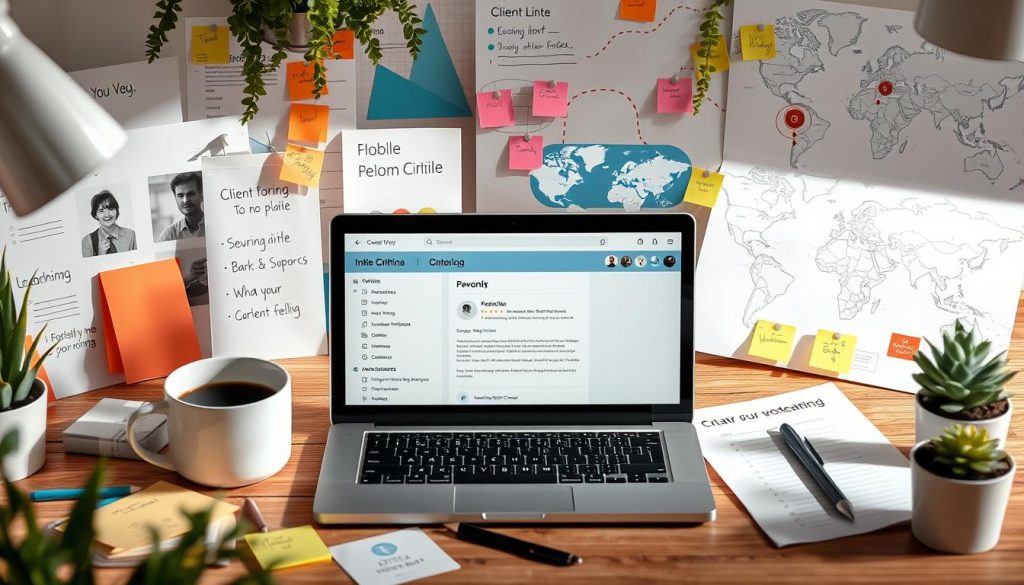In the competitive world of business brokerage, cold emails have become a vital tool for lead generation. Business brokers who master the art of crafting compelling cold emails can unlock new opportunities and close more deals. This guide delves into advanced strategies that will help you elevate your cold email game and stand out in a crowded inbox.
Cold emails offer a direct line to potential clients, allowing business brokers to showcase their expertise and value proposition. By implementing targeted approaches and personalized messaging, you can transform cold outreach into warm leads. Let’s explore how to harness the power of cold emails to boost your brokerage business and drive results.
Key Takeaways
- Craft personalized subject lines to increase open rates
- Tailor your message to the specific needs of your target audience
- Use market research to identify high-potential prospects
- Implement A/B testing to optimize your email campaigns
- Develop a strategic follow-up plan to maximize responses
- Leverage automation tools to scale your cold email efforts
Understanding the Importance of Cold Emails
Cold emails are a vital tool for business brokers seeking to expand their client base. This outreach method allows brokers to connect with potential clients directly, offering their services and expertise.
What is a Cold Email?
A cold email is an unsolicited message sent to a recipient without prior contact. For business brokers, it’s a way to introduce themselves and their services to potential clients who might be interested in buying or selling a business.
Why Cold Emails Matter for Business Brokers
Cold emails are crucial for business brokers as they provide a cost-effective way to reach a large audience. They allow brokers to showcase their expertise, build relationships, and generate leads without the need for face-to-face meetings or expensive advertising campaigns.
Key Benefits of Effective Cold Emailing
Effective cold emailing offers several advantages for business brokers:
- Increased lead generation
- Cost-effective marketing
- Scalability in reaching potential clients
- Ability to target specific industries or business sizes
- Opportunity to showcase expertise and value proposition
| Benefit | Impact on Business Brokers |
|---|---|
| Lead Generation | Higher number of potential clients |
| Cost-Effectiveness | Lower marketing expenses |
| Scalability | Ability to reach more prospects |
| Targeting | Improved relevance of outreach |
| Expertise Showcase | Enhanced credibility and trust |
By mastering cold email strategies, business brokers can significantly improve their email outreach efforts and grow their client base effectively.
Identifying Your Target Audience
For business brokers, pinpointing the right target audience is crucial for effective lead generation. Knowing who to reach out to can make or break your cold email campaigns. Let’s explore how to define your ideal client and use market research to find promising prospects.
Defining Your Ideal Client
Start by creating a profile of your perfect client. Consider factors like:
- Business size and revenue
- Industry or niche
- Geographic location
- Years in operation
- Current business challenges
This profile helps focus your efforts on businesses most likely to need your services. Remember, a well-defined target audience leads to more successful cold email campaigns.
https://www.youtube.com/watch?v=iHYcO2gulOc
Using Market Research to Hone in on Prospects
Market research is key to refining your target audience. Use these strategies:
- Analyze past successful deals
- Study industry trends and forecasts
- Conduct surveys or interviews with current clients
- Use online tools to gather data on potential prospects
By combining your ideal client profile with solid market research, you’ll create a targeted list of high-potential leads. This focused approach improves your chances of connecting with businesses ready for your expertise as a broker.
“The key to successful lead generation is knowing exactly who you’re trying to reach and why they need you.”
Crafting the Perfect Cold Email Subject Line
The subject line is your first impression in email outreach. It can make or break your cold email campaign. A well-crafted subject line entices recipients to open your message, setting the stage for successful communication.
Tips for Writing Attention-Grabbing Subject Lines
Crafting effective subject lines for cold emails requires creativity and strategy. Here are some tips to boost your open rates:
- Keep it short and sweet (under 50 characters)
- Use personalization to grab attention
- Create a sense of urgency or curiosity
- Avoid spam trigger words
- Be clear and specific about your offer
Examples of Effective Subject Lines for Business Brokers
Let’s look at some subject lines that work well for business brokers in their email outreach:
| Subject Line | Why It Works |
|---|---|
| [Name], interested in selling your business? | Personalizes and directly addresses the recipient’s potential need |
| Confidential: Your business valuation inside | Creates curiosity and implies valuable information |
| 5 reasons to consider selling now | Uses a number to grab attention and suggests timely advice |
| Quick question about [Company Name] | Seems personal and non-intrusive, encouraging opens |
| Maximize your exit strategy – free consultation | Offers value and a clear call-to-action |
Remember, the key to successful cold emails lies in testing different subject lines. What works for one audience may not work for another. Continuously refine your approach based on open rates and responses to improve your email outreach effectiveness.
Personalization Techniques for Cold Emails
Personalization is key to successful cold emails. By tailoring your message to each recipient, you increase the chances of getting a response. Let’s explore effective personalization techniques and tools for business brokers.
Customizing Your Messaging
To personalize your cold emails, start by researching your prospects. Look for shared connections, recent company news, or industry trends. Use this information to craft a unique opening that shows you’ve done your homework. For example, mention a recent achievement or congratulate them on a business milestone.

Next, focus on addressing the recipient’s specific pain points. Tailor your value proposition to their needs, explaining how your services can solve their unique challenges. This approach demonstrates that you understand their business and aren’t sending generic mass emails.
Tools for Personalizing Cold Emails
Several tools can help streamline your email outreach efforts:
- LinkedIn Sales Navigator: Gather detailed information about prospects
- Hunter.io: Find verified email addresses
- Mailshake: Automate personalized email sequences
- Lemlist: Create personalized images and landing pages
These tools allow you to scale your personalization efforts without sacrificing quality. By combining automation with thoughtful customization, you can create cold emails that resonate with your target audience and drive better results for your business brokerage.
Structuring Your Cold Email for Success
Crafting effective cold emails is crucial for business brokers looking to connect with potential clients. A well-structured email can make the difference between a response and being ignored. Let’s explore the key elements of successful cold emails and common pitfalls to avoid.
Key Elements of an Effective Cold Email
A winning cold email structure includes several essential components:
- Attention-grabbing subject line
- Personalized greeting
- Brief introduction
- Value proposition
- Clear call-to-action
- Professional signature
Business brokers should focus on crafting concise, value-driven messages that resonate with their target audience. Personalization is key to standing out in crowded inboxes.
Common Mistakes to Avoid in Your Email Structure
When structuring cold emails, business brokers often make these mistakes:
| Mistake | Impact | Solution |
|---|---|---|
| Long-winded introductions | Lose reader’s interest | Keep it brief and focused |
| Generic content | Lack of relevance | Personalize each email |
| Unclear call-to-action | No direction for recipients | Provide a specific next step |
| Overly promotional tone | Appears pushy or salesy | Focus on recipient’s needs |
By avoiding these pitfalls and focusing on a clear, concise email structure, business brokers can significantly improve their cold email success rates and build stronger connections with potential clients.
Writing Engaging Email Content
Crafting compelling email content is crucial for successful cold emails and lead generation. The right words can captivate your audience and drive action. Let’s explore strategies to create engaging emails that resonate with potential clients.
Tips for Creating Compelling Copy
To write persuasive email content, focus on your recipient’s needs. Start with a strong opening that grabs attention. Use clear, concise language and avoid jargon. Highlight the value you offer and include a specific call-to-action. Personalize your message to make it relevant and appealing.
- Keep it brief and to the point
- Use active voice for stronger impact
- Include social proof or testimonials
- Address pain points and offer solutions

The Power of Storytelling in Cold Emails
Storytelling can transform your cold emails from bland to captivating. Share a brief success story or case study that relates to your prospect’s situation. This approach helps build trust and demonstrates your expertise. Use storytelling to illustrate how your services can solve their problems or improve their business.
“Stories are the single most powerful weapon in a leader’s arsenal.” – Howard Gardner
By incorporating these strategies into your email content, you’ll create more engaging cold emails that boost your lead generation efforts. Remember to always tailor your message to your audience and provide genuine value in every interaction.
A/B Testing Your Cold Email Campaigns
A/B testing is a game-changer for cold email campaigns. It helps you fine-tune your email outreach and boost results. Let’s dive into what A/B testing is and how to use it effectively.
What is A/B Testing?
A/B testing for cold emails involves sending two versions of an email to different segments of your audience. You compare the performance of each version to see which one gets better results. This method lets you optimize your cold emails based on real data.
How to Conduct A/B Tests on Cold Emails
To run an A/B test on your cold emails:
- Choose one element to test (subject line, opening, call-to-action, etc.)
- Create two versions of your email, changing only that element
- Split your email list randomly into two groups
- Send each version to a different group
- Track key metrics like open rates, click-through rates, and responses
- Analyze the results to determine the winning version
- Use the insights to improve future cold email campaigns
Remember, A/B testing is an ongoing process. Keep testing different elements to continuously improve your cold email performance. With consistent A/B testing, you’ll craft more effective cold emails that resonate with your target audience and drive better results.
Follow-Up Strategies After Sending Cold Emails
Cold emails are a crucial tool for business brokers, but the real magic happens in the follow-up. A well-crafted follow-up strategy can turn silence into success. Let’s explore how to time your follow-ups and create emails that get responses.
Timing Your Follow-Ups Effectively
Timing is everything when it comes to follow-up emails. Business brokers should aim to strike a balance between persistence and patience. Here’s a suggested timeline:
- First follow-up: 3-4 days after initial cold email
- Second follow-up: 7-10 days after the first follow-up
- Third follow-up: 14-21 days after the second follow-up
This spacing allows time for prospects to respond while keeping your message fresh in their minds. Remember, each industry may have different rhythms, so adjust accordingly.
Crafting Follow-Up Emails That Get Responses
To boost your response rates, focus on value in your follow-up emails. Here are key elements to include:
- Reference your previous email
- Offer new, relevant information
- Keep it brief and to the point
- End with a clear call-to-action
By following these strategies, business brokers can significantly improve their cold email campaigns. Remember, persistence pays off, but always respect your prospect’s time and inbox.
Measuring the Success of Your Cold Email Campaigns
Tracking the right email metrics is crucial for optimizing your cold email campaigns and boosting lead generation. By analyzing key performance indicators, business brokers can refine their strategies and achieve better results.
Key Metrics to Track for Cold Emails
To gauge the effectiveness of your cold emails, focus on these essential metrics:
- Open Rate: Percentage of recipients who opened your email
- Click-Through Rate (CTR): Percentage of recipients who clicked on links
- Response Rate: Percentage of recipients who replied to your email
- Conversion Rate: Percentage of recipients who took desired action
- Bounce Rate: Percentage of emails that weren’t delivered
Tools for Analyzing Cold Email Performance
Leverage these powerful tools to track and analyze your cold email performance:
| Tool | Key Features | Best For |
|---|---|---|
| Mailchimp | Comprehensive analytics, A/B testing | Small to medium businesses |
| HubSpot | CRM integration, advanced reporting | Large enterprises |
| Woodpecker | Automated follow-ups, personalization | Cold email specialists |
| Yesware | Real-time tracking, templates | Sales teams |
By consistently monitoring these email metrics and using the right tools, business brokers can fine-tune their cold email strategies for maximum impact and improved lead generation results.
Scaling Your Cold Email Efforts
In the competitive $1.8 billion business brokerage industry, scaling cold email efforts is crucial for success. Business brokers can leverage email automation to reach more prospects and close deals efficiently. By adopting smart strategies, brokers can expand their reach while maintaining personalized communication.
Automation Tools for Business Brokers
Email automation tools help business brokers streamline their outreach. Popular platforms like Mailchimp and ActiveCampaign offer features tailored for cold email campaigns. These tools allow brokers to schedule emails, segment lists, and track engagement. By using automation, brokers can focus on high-value tasks while nurturing leads automatically.
Best Practices for Scaling Cold Email Campaigns
When scaling cold emails, quality should never be sacrificed for quantity. Brokers should maintain personalization even as they increase volume. Using dynamic fields and custom variables helps create tailored messages at scale. It’s vital to monitor metrics like open rates and responses to ensure effectiveness. By following these practices, business brokers can grow their outreach while keeping their messages impactful and relevant.
FAQ
What is the ideal length for a cold email?
The ideal length for a cold email is typically between 50-125 words. This length is concise enough to maintain the reader’s attention while providing sufficient information to pique their interest. However, the exact length may vary depending on your specific audience and message complexity.
How often should I send follow-up emails?
It’s generally recommended to send 2-3 follow-up emails spaced 3-7 days apart. The first follow-up can be sent 3-4 days after the initial email, with subsequent follow-ups spaced slightly further apart. Always respect the recipient’s inbox and cease outreach if they express disinterest.
What are some effective subject lines for business broker cold emails?
Effective subject lines for business broker cold emails should be concise, personalized, and value-oriented. Examples include: “Opportunity: Maximize Your Business Value,” “Confidential: Exit Strategy for [Company Name],” or “Quick Question About [Company Name]’s Future.” Always test different variations to see what resonates best with your audience.
How can I improve my cold email open rates?
To improve cold email open rates, focus on crafting compelling subject lines, personalizing the sender name, optimizing send times, segmenting your email list, and regularly cleaning your email list to remove inactive contacts. Additionally, ensure your email content is relevant and valuable to the recipient.
What are some common mistakes to avoid in cold emailing?
Common mistakes in cold emailing include using generic templates, failing to personalize content, writing overly long emails, neglecting to include a clear call-to-action, sending emails at inappropriate times, and not following up. Also, avoid using deceptive subject lines or making unrealistic promises in your email content.
How can I personalize my cold emails at scale?
To personalize cold emails at scale, utilize CRM systems and email automation tools that allow for dynamic content insertion. Research your prospects thoroughly and use this information to create personalized snippets. Segment your email list based on industry, company size, or other relevant factors to tailor your messaging effectively.
What metrics should I track to measure cold email success?
Key metrics to track for cold email success include open rate, click-through rate (CTR), response rate, conversion rate, and bounce rate. Additionally, monitor unsubscribe rates and overall ROI of your email campaigns. These metrics will help you gauge the effectiveness of your cold email strategy and identify areas for improvement.
How can I ensure my cold emails don’t end up in spam folders?
To avoid spam folders, use a reputable email service provider, authenticate your domain with SPF and DKIM records, maintain a clean email list, avoid spam trigger words, and encourage recipients to add your email to their address book. Additionally, focus on creating high-quality, relevant content that engages your audience.
What is the best time to send cold emails?
The best time to send cold emails can vary depending on your target audience. However, studies generally suggest that Tuesday, Wednesday, and Thursday mornings between 10 AM and 11 AM local time tend to have higher open rates. It’s crucial to test different send times with your specific audience to determine the optimal timing for your campaigns.
How can I use A/B testing to improve my cold email campaigns?
A/B testing can significantly improve your cold email campaigns by allowing you to test different elements such as subject lines, email content, send times, and calls-to-action. Start by identifying one variable to test, create two versions of your email, split your audience randomly, and analyze the results to determine which version performs better. Continuously apply these insights to refine your email strategy.


